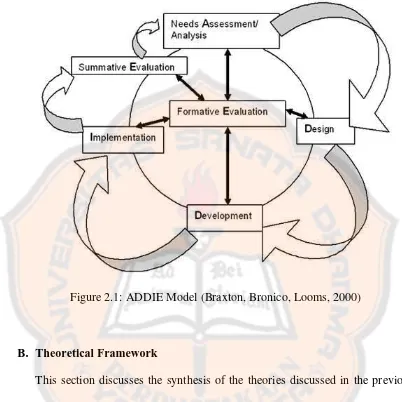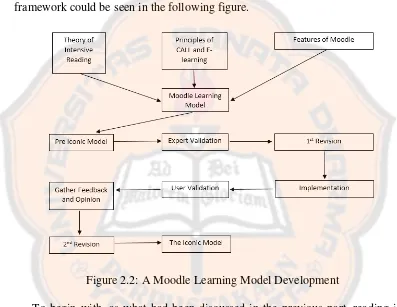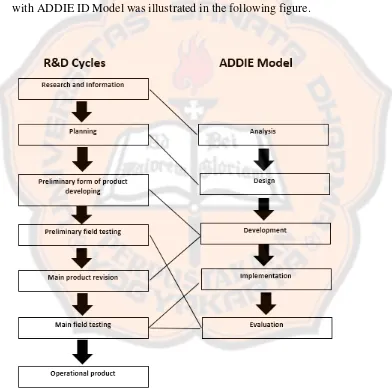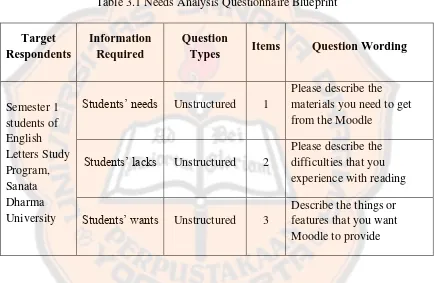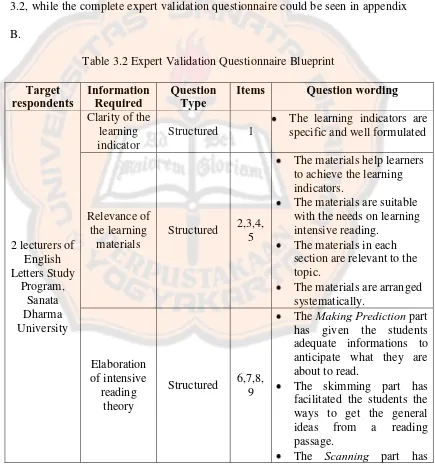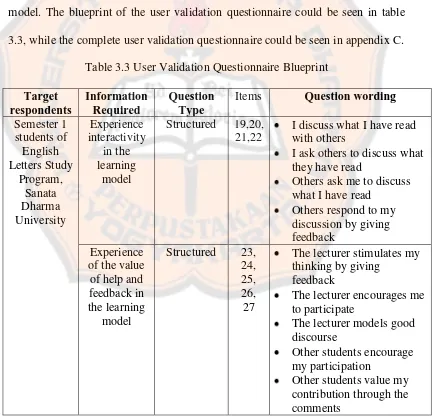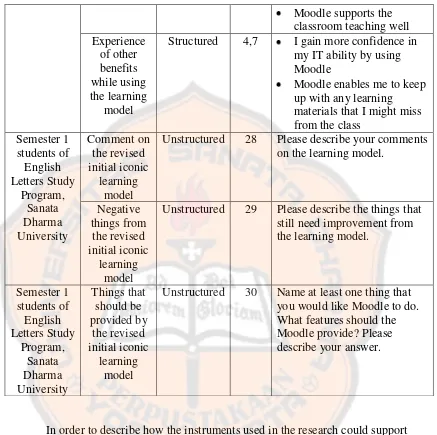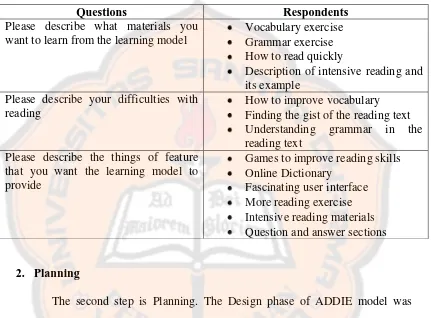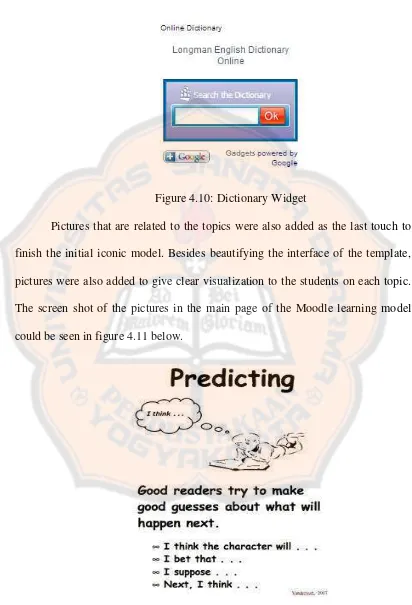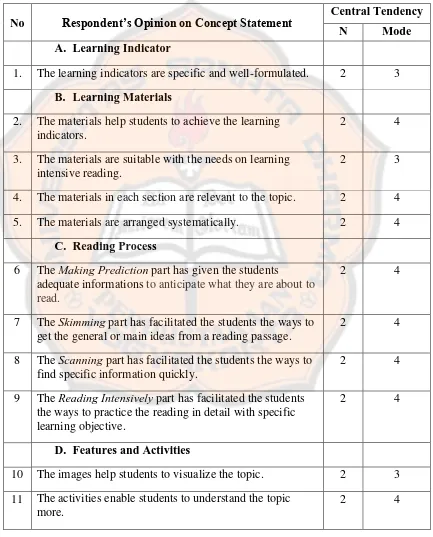i
Baskara, FX. Risang. 2014. A Moodle Learning Model for Intensive Reading at the University Level. Yogyakarta: Graduate Program on English Language Studies, Sanata Dharma University.
E-Learning settings have a role in the teaching and learning process. Designing adapted e-learning materials requires great requirements on web design, software design skills, and time. A substitution to this can be an organization of materials within learning management systems. Moodle, as a form of e-learning, is “open source”, allowing teachers to adapt the materials to individual needs. It also connects very well with many web-based resources, allowing teachers creativity and versatility. Therefore, it is considered necessary to develop a Moodle learning model, especially for intensive reading at the university level. Two research problems were formulated: (1) What is the theoretical model of the Moodle learning model for intensive reading at the university level like? (2) What is the iconic model of the Moodle learning model for intensive reading at the university level like?
ii
Baskara, FX. Risang. 2014. A Moodle Learning Model for Intensive Reading at the University Level. Yogyakarta: Graduate Program on English Language Studies, Sanata Dharma University.
Situasi e -learning memiliki peran dalam proses belajar mengajar . Merancang materi e-learning yang sudah diadaptasi membutuhkan tuntutan tinggi pada desain, keterampilan pemrograman, dan waktu. Sebuah alternative yang lain bisa dengan sebuah kumpulan materi dalam sistem manajemen pembelajaran. Moodle, sebagai salah satu bentuk e-learning, adalah “sumber terbuka", yang memungkinkan para guru untuk mengadaptasi bahan-bahan untuk kebutuhan individu . Moodle ini juga terhubung dengan sangat baik dengan banyak sumber berbasis web, yang memungkinkan kreativitas dan fleksibilitas para guru. Oleh karena itu, dipandang perlu untuk mengembangkan model pembelajaran Moodle, terutama untuk membaca intensif di tingkat universitas. Terdapat dua rumusan masalah: (1) Seperti apakah model teoritis dari model pembelajaran Moodle untuk membaca intensif di tingkat universitas? (2) Seperti apakah model ikonik dari model pembelajaran Moodle untuk membaca intensif di tingkat universitas?
Untuk menjawab rumusan masalah tersebut, digunakan model perancangan instruksional ADDIE yang terdiri dari lima fase, yaitu: Analisis, Perancangan, Pengembangan, Implementasi dan Evaluasi. Model perancangan tersebut digabungkan ke dalam siklus Penelitian dan Pengembangan milik Borg dan Gall: Penelitian dan Pengumpulan Informasi, Perencanaan, Pengembangan Bentuk Awal Produk, Pengujian Awal di Lapangan, Revisi Produk, Pengujian Utama di Lapangan dan Revisi Produk Operasional.. Data diperoleh melalui kuesioner yang dibagikan kepada siswa kelas membaca intensif di Program Studi Sastra Inggris, Universitas Sanata Dharma dan juga untuk dua orang dosen dari Program Studi Sastra Inggris Universitas Sanata Dharma.
A MOODLE LEARNING MODEL
FOR INTENSIVE READING AT THE UNIVERSITY LEVEL
A THESIS
Presented as a Partial Fulfillment of the Requirements
to Obtain the Magister Humaniora (M.Hum.) Degree
in English Language Studies
by
FX. Risang Baskara
116332034
THE GRADUATE PROGRAM OF ENGLISH LANGUAGE STUDIES
SANATA DHARMA UNIVERSITY
i
A MOODLE LEARNING MODEL
FOR INTENSIVE READING AT THE UNIVERSITY LEVEL
A THESIS
Presented as a Partial Fulfillment of the Requirements
to Obtain the Magister Humaniora (M.Hum.) Degree
in English Language Studies
by
FX. Risang Baskara
116332034
THE GRADUATE PROGRAM OF ENGLISH LANGUAGE STUDIES
SANATA DHARMA UNIVERSITY
vi
ACKNOWLEDGEMENTS
I would like to deliver my sincere gratitude to God and people who have been supporting me during the thesis writing.
I would like to extend my deepest gratitude to My Savior Jesus Christ for His endless blessings. Without Him and His blessings, I would never have finished my thesis. I also give my thanks to my parents for their prayers, encouragement and support.
I am most grateful to my thesis advisor FX. Mukarto, Ph.D., for his patience, hospitality, and guidance during my thesis writing. His criticisms and advice have been very supportive and helpful.
I am also indebted to Dr. B.B. Dwijatmoko and Dr. J. Bismoko, for their creditable inputs and suggestions during the Grand Thesis Seminar. I am also thankful to Dr. Novita Dewi, M.S., M.A. (Hons), for the knowledge she shares during my study in KBI.
I would like to give my special thanks to my SEAMOLEC classmates – Mbak Sisca, Pak Joko, Mbak Dita, Daniel, Hebi, Uke, and Diaz for their support and care. I am glad we are friends as I learn a lot from them. I also thank all my 2011 classmates and Mbak Lely for the warm and friendly environment.
vii
This graduate thesis is dedicated to
My beloved mother
My generous father
viii
TABLE OF CONTENTS
Page
TITLE PAGE ... i
APPROVAL PAGES ... ii
STATEMENT OF ORIGINALITY ... iv
LEMBAR PERNYATAAN PERSETUJUAN PUBLIKASI KARYA ILMIAH UNTUK KEPENTINGAN AKADEMIS ... v
ACKNOWLEDGEMENTS ... vi
DEDICATION PAGE... vii
TABLE OF CONTENTS ... viii
LIST OF TABLES ... xii
LIST OF FIGURES ... xii
LIST OF APPENDICES ...xvi
ABSTRACT ...xvii
ABSTRAK...xviii
CHAPTER I: INTRODUCTION A. Research Background ... 1
B. Problem Identification ... 5
C. Research Limitation ... 8
D. Research Delimitation ... 8
ix
F. Research Goals ... 9
G. Product Specification ... 9
H. Research Benefits ... 10
CHAPTER II: LITERATURE REVIEW A. Theoretical Review ... 11
1. Review of Related Research ... 11
2. Reading ... 15
a. Nature of Reading ... 15
b. Approaches in reading EFL classrooms..………...……..………… 16
c. Types of reading ... 18
d. Reading Strategies………..19
3. Computer-Assisted Language Learning Theory... 23
4. E-Learning (Electronic Learning)... 27
a. Definition of E-Learning ... 27
b. Learning Concepts in E-Learning ... 28
5. MOODLE ... 28
a. Definition……….28
b. Features of Moodle………..29
6. Instructional Design Model………...31
x CHAPTER III: RESEARCH METHODOLOGY
A. Research Method ... 41
B. Research Respondents ... 46
C. Research Instruments ... 47
D. Data Gathering Procedures ... 57
E. Data Analysis Procedures ... 58
F. Research Procedure………. 60
CHAPTER IV: RESULTS AND DISCUSSION A. Theoretical Model of the Moodle Learning Model ... 62
1. Research and Information…….. ... 62
2. Planning ... 67
B. Iconic Model of the Moodle Learning Model ... 71
1. Preliminary Form of Product Developing ... 73
2. Preliminary Field Testing ... 81
3. Main Product Revision ... 86
4. Main Field Testing ... 89
5. Operational Product Revision………..123
CHAPTER V: CONCLUSIONS AND SUGGESTIONS A. Conclusions... 130
xi
BIBLIOGRAPHY...137
xii
LIST OF TABLES
Table Page
3.1 Needs Analysis Questionnaire Blueprint ... 50
3.2 Expert Validation Questionnaire Blueprint ... 51
3.3 User Validation Questionnaire Blueprint ... 54
3.4 Data Collection ... 57
3.5 Data Gathering Techniques ... 58
3.6 Degree of Agreement ... 59
3.7 Research Procedures ... 61
4.1 The Results Summary of Needs Analysis Questionnaire ... 67
4.2 Topics of the Learning Model ... 68
4.3. The Organization of Subject Contents ... 68
4.4 The General Purposes ... 69
4.5 The Learning Indicators ... 70
4.6 Summary of the First Part of Expert Validation Questionnaire ... 82
4.7 Meanings of the First Part of the Expert Validation Questionnaire ... 84
4.8 Results of Essay Questions of Expert Validation Questionnaire ... 85
4.9 The Statements in the Questionnaire for User Validation... ..94
4.10 Meanings of the First Part of the User Validation Questionnaire ... ..96
xiii
LIST OF FIGURES
Figure Page
2.1 ADDIE Instructional Design Model ... 34
2.2 Theoretical Model and Iconic Model Development ... 35
3.1 R & D Adopted Cycle Collaborated with ADDIE Model ... 45
4.1 File Feature ... 73
4.2 Folder Feature ... 74
4.3 Label Feature ... 75
4.4 URL Feature ... 75
4.5 True / False Quiz ... 76
4.6 Forum Feature ... 77
4.7 Clock Widget ... 78
4.8 Calendar Widget... 78
4.9 Mini-game Widget ... 79
4.10 Dictionary Widget ... 80
4.11 Pictures in the Learning Model ... 80
4.12 Revision on Interface ... 87
4.13 Revision on Instruction ... 88
4.14 Revision on Activities ... 88
4.15 First Topic ... ..90
4.16 Second Topic ... ..91
xiv
4.18 Fourth Topic ... 93
4.19 Mode of Statement Nineteen ... 98
4.20 Mode of Statement Twenty ... 99
4.21 Mode of Statement Twenty-One ... 100
4.22 Mode of Statement Twenty-Two ... 101
4.23 Mode of Statement Twenty-Three ... 102
4.24 Mode of Statement Twenty-Four ... 103
4.25 Mode of Statement Twenty-Five ... 104
4.26 Mode of Statement Twenty-Six ... 105
4.27 Mode of Statement Twenty-Seven ... 105
4.28 Mode of Statement Nine ... 107
4.29 Mode of Statement Fourteen ... 107
4.30 Mode of Statement Fifteen ... 108
4.31 Mode of Statement Seventeen ... 109
4.32 Mode of Statement One ... 110
4.33 Mode of Statement Three ... 111
4.34 Mode of Statement Five ... 111
4.35 Mode of Statement Six ... 112
4.36 Mode of Statement Eight ... 113
4.37 Mode of Statement Twelve ... 113
4.38 Mode of Statement Sixteen ... 114
4.39 Mode of Statement Four ... 115
xv
4.41 Mode of Statement Two ... 117
4.42 Mode of Statement Ten ... 117
4.43 Mode of Statement Eleven ... 118
4.43 Mode of Statement Thirteen ... 119
4.45 Mode of Statement Eighteen ... 119
4.46 Advertisements in Moodle ... 124
4.47 Pictures in the activities ... 125
4.48 Google custom search engine... 126
4.49 Wikipedia widget ... 126
4.50 Pac man original widget ... 127
4.51 Remote RSS Feeds block ... 128
xvi
LIST OF APPENDICES
Appendix Page
Appendix A: Questionnaire for Needs Analysis ... 142
Appendix B: Questionnaire for Expert Validation... 144
Appendix C: Questionnaire for User Validation ... 149
Appendix D: The Results of the Questionnaire for Expert Validation ... .154
Appendix E: The Results of the Questionnaire for User Validation ... 159
Appendix F: The Intensive reading Course Syllabus ... 165
xvii
Baskara, FX. Risang. 2014. A Moodle Learning Model for Intensive Reading at the University Level. Yogyakarta: Graduate Program on English Language Studies,Sanata Dharma University.
E-Learning settings have a role in the teaching and learning process. Designing adapted e-learning materials requires great requirements on web design, software design skills, and time. A substitution to this can be an organization of materials within learning management systems. Moodle, as a form of e-learning, is “open source”, allowing teachers to adapt the materials to individual needs. It also connects very well with many web-based resources, allowing teachers creativity and versatility. Therefore, it is considered necessary to develop a Moodle learning model, especially for intensive reading at the university level. Two research problems were formulated: (1) What is the theoretical model of the Moodle learning model for intensive reading at the university level like? (2) What is the iconic model of the Moodle learning model for intensive reading at the university level like?
To answer the research questions, the ADDIE Instructional Design model consisting of five phases: Analysis, Design, Development, Implementation and Evaluation was employed. The model were combined with the Borg and Gall’s cycles of Research and Development: Research and Information Collecting, Planning, Developing Preliminary Form of Product, Preliminary Field Testing, Main Product Revision, Main Field Testing and Operational Product Revision. The data were obtained through questionnaires, which were distributed to the intensive reading class students of the English Letters Study Program of Sanata Dharma University and also to two lecturers of the English Letters Study Program of Sanata Dharma University.
The results of the research are the theoretical model and the iconic model of the Moodle learning model. The theoretical model presents the features and widgets that were selected according to their suitability with the theory of intensive reading as well as with the CALL principles. The first feature used was
resources in the form of File, Folder, Label and URL. The second feature was
quiz in the form of multiple choice. The last feature used was forum. The widgets added were clock, calendar, game, and online dictionary. The iconic model was developed by making some revisions based on the results of the expert validation and the user validation. The iconic learning model could be accessed on readingclass.mld2.com.
xviii
Baskara, FX. Risang. 2014. A Moodle Learning Model for Intensive Reading at the University Level. Yogyakarta: Graduate Program on English Language Studies,Sanata Dharma University.
Situasi e -learning memiliki peran dalam proses belajar mengajar . Merancang materi e-learning yang sudah diadaptasi membutuhkan tuntutan tinggi pada desain, keterampilan pemrograman, dan waktu. Sebuah alternative yang lain bisa dengan sebuah kumpulan materi dalam sistem manajemen pembelajaran. Moodle, sebagai salah satu bentuk e-learning, adalah “sumber terbuka", yang memungkinkan para guru untuk mengadaptasi bahan-bahan untuk kebutuhan individu . Moodle ini juga terhubung dengan sangat baik dengan banyak sumber berbasis web, yang memungkinkan kreativitas dan fleksibilitas para guru. Oleh karena itu, dipandang perlu untuk mengembangkan model pembelajaran Moodle, terutama untuk membaca intensif di tingkat universitas. Terdapat dua rumusan masalah: (1) Seperti apakah model teoritis dari model pembelajaran Moodle untuk membaca intensif di tingkat universitas? (2) Seperti apakah model ikonik dari model pembelajaran Moodle untuk membaca intensif di tingkat universitas?
Untuk menjawab rumusan masalah tersebut, digunakan model perancangan instruksional ADDIE yang terdiri dari lima fase, yaitu: Analisis, Perancangan, Pengembangan, Implementasi dan Evaluasi. Model perancangan tersebut digabungkan ke dalam siklus Penelitian dan Pengembangan milik Borg dan Gall: Penelitian dan Pengumpulan Informasi, Perencanaan, Pengembangan Bentuk Awal Produk, Pengujian Awal di Lapangan, Revisi Produk, Pengujian Utama di Lapangan dan Revisi Produk Operasional.. Data diperoleh melalui kuesioner yang dibagikan kepada siswa kelas membaca intensif di Program Studi Sastra Inggris, Universitas Sanata Dharma dan juga untuk dua orang dosen dari Program Studi Sastra Inggris Universitas Sanata Dharma.
1
CHAPTER I
INTRODUCTION
This chapter provides general explanations of what the researcher discuss in this thesis. The introductory part contains several subheadings, namely: Research Background, Problem Formulation, Problem Limitations, Research Objectives, Product Specification, and Benefits of the Study. The research background gives the reason why the research is necessary to study. The problems limitation explains the theoretical and technical limitations of the study. The problem formulation specifies the questions that the study wants to answer. The research objectives state the goals that the study aims to achieve. The research benefits state the advantage that readers will gain by reading the thesis.
A. Research Background
Web can support language teachers to integrate Web resources into the language classroom (Warschauer, 2001). It could be moreover a virtual library that has a huge measure of qualified data valuable to English as a second language (ESL) teaching (Warschauer & Healey, 1998). Moreover, Web-based language learning has the potential to increase learner cause and engage learners in habitually authentic and remarkably interactive language experience (Chun & Plass, 2000).
effective and creative decision-making. Many universities worldwide have attempted to identify similar qualities they aim to inculcate in their graduates.
These days with the fast dispersion of the Internet, frameworks furnishing whenever and at whatever location electronic learning have ended up being conceivable. This sort of online is one of the best systems to supplement up close and personal lessons in classrooms. For instance, electronic learning has favorable circumstances in that self-regulated and agreeable learning between learner and educator is conceivable. In the not so distant past, electronic learning apparatuses of different sorts or composing devices that might be used for instructing and learning have been presented diversely. However, as a matter of fact, in Indonesia is old fashioned, making it almost innovatively unlikely to execute a framework where instructors can make substance, and transfers to the server and performs nonstop upgrades, and therefore the framework would not be able to convey online substance of exceptional value. One such framework improved for educators for operating learning, which attempts to beat this imperfection and give online substance of exceptional value, is the Moodle.
web-based Learning Management Systems (LMS) that support teaching/learning process and MOODLE is one of them. It has some useful features which facilitate the students to share links to relevant sites that support their writing (link sharing), publish students‟ writings into threaded form (conferencing) and give students
opportunity to have individual consultation (personal messaging). Considered as a useful site, the researcher has not found any instructional materials which utilize this tool which becomes the main reason for conducting this research.
Moodle is an application program that can change the learning media into the form of a web. This application enables learners to enter a “digital classroom” to access the learning materials. Moodle provides interactivity which is able to provide interaction room for the user (student) with the program. This interaction is undertaken in two conditions, first, the effectiveness of the program in providing clear instruction, and second, how the program could give feedback on students‟ learning. Furthermore, usability or flexibility is the second requirement
to justify Moodle as media to teach language particularly the teaching reading. Usability refers to easiness and interest the program might offer to the students to conduct the distance learning via internet. In addition, the usability or flexibility of CALL program is seen on side where students could easily explore the learning materials on the website. The next aspect is performance. The performance is viewed as images used by the application to lead students‟ interest. In developing
with sounds, picture and video as well. The presence of images, sound and video might be beneficial to assist students comprehend the reading passages. This multimedia of course would be a value for students‟ further learning particularly in reading lesson. Those aspects will be very beneficial in learning reading. All the reasons above have become the motivation to design a Moodle learning model for intensive reading in particular. It was because Reading is one of the English language skills aside from Listening, Speaking and Writing. Therefore, it is one of the subjects offered in the study program in which this research will take place. Access to teach has also become one contributing reason since it would certainly ease the procedure regarding the permission to teach
B. Problem Identification
for educators for maintaining learning, which can furnish electronic online addresses of great value. The Moodle LMS utilizes constructivism-learning hypothesis as the organization in examination with different LMS frameworks. Even though in light of the fact that the record plan is isolated, boosting user benefit, and flexibility, it has offers that are advantageous for educators to use. Moreover, the security and administration tools are unyielding and the IMS / SCORM standard of educational content improvement is supported (Park, 2008).
There are two approaches in teaching students to understand information in the context of reading; namely an extensive approach and intensive approach (Aebersold and Field, 1997: 42-46). According to Aebersold and Field (1997: 43), an extensive approach in teaching reading is mainly relied on “the belief that
when students read for general comprehension large quantities of text of their own choosing their ability to read will consequently improve.” Thus, most activities of teaching and learning reading are mostly applied outside of the classroom. In addition, the other intensive teaching reading approach puts teacher‟s role to monitor students‟ reading activities particularly in providing direction and
assistance just before the activities are applied. When students start doing their reading activities, teacher is urged to make sure that students might have arrived on proportional understanding toward the materials they select. Teacher is determined to make some reading exercises to find certain level of students‟
within the reading (Aebersold and Field, 1997: 45). In addition, teacher is to be observer where he keeps himself away from students‟ reading activity. Teacher in this space is expected to record students‟ progress that later he might have it as
valuable information in organizing feedback to their students.
All the reasons above has built up the researcher‟s way of thinking to
design a web-based tool to teach Intensive Reading subject, that is one of the obligatory subjects offered in the first semester in English Letters Study Program of Sanata Dharma University, with the use of information technology that focus on an Open Source website, so-called MOODLE. How is a web-based learning tool using Moodle designed? What kind of attitudes come up while they are learning Intensive Reading by using information technology? What are the advantages and disadvantages of the use of Moodle in teaching and learning Intensive Reading subject? In further learning, they can automatically learn by themselves, autonomous after several times, so it investigated „how to‟, „why‟ and
„what‟ questions.
C. Problem Limitation
In order to make constraints of this research, the researcher determines some limitations. First, this research focuses only on the developing materials for English Reading skill, not discussing the material design of other skills, such as Speaking, Writing, and Listening. Second, the research employs the theory of reading, and Computer Assisted Language Learning Theory in designing the materials. Third, the goals, general purposes, and topics of the materials are arranged in accordance with the curriculum as formulated in the syllabus for Intensive Reading subject. Fourth, the tool which is utilized in this study is Online MOODLE which is one of many web-based Learning Management Systems (LMS). One reason why the researcher chooses Moodle as the tool and not other electronic tools is because no HTML or PHP or any form of web knowledge or skills needed by users. Thus, teachers and students will access it easily. The population used in the sampling of the research is also limited to forty eight students of semester I from two chosen classes of English Letters USD. Further explanation about the research subject will be elaborated later on in the Chapter III.
D. Research Delimitation
reading. Moodle offers so many features to help conveying the materials. However, in this research, only some of those features will be used due to the limitation of time.
E. Research Questions
The researcher proposes two questions to be answered, and thus being the guideline of the process of research and the writing. Those questions are:
1. What is the theoretical model of the Moodle learning model for Intensive Reading at the university level like?
2. What is the Moodle learning model for Intensive Reading at the university level like?
F. Research Goals
First, this research aims to present the theoretical model that will serve as the basis for the development of the iconic model. Next, this research aims to develop the practical or ready-to-use model that will be implemented to the students.
G. Product Specifications
to improve the students‟ ability read intensively. The materials that will be presented in the model are mainly the theories on intensive reading and the skills in the intensive reading. This model is in the form of a website. Moodle software is used to design the model. The allocated time is four meetings.
H. Research Benefits
11
CHAPTER II
LITERATURE REVIEW
This chapter discusses the theories and how they are used in answering the questions in the problem formulation. The chapter of literature review is divided into: (1) theoretical review; (2) theoretical framework. The theoretical review covers the relevant theories, which are essential for the analyses. The theoretical framework gives description on how the reviewed theories are used in the analyses.
A. THEORETICAL REVIEW
This theoretical review would discuss the theories used in this research. Those theories are the (1) Review of Related Research, (2) Reading, (3) CALL Theory, (4) E-learning, (5) Moodle, and (6) Instructional Design Model.
1. Review of Related Research
essay writing. The product of this research will be able to be used by the university where the research was conducted. This research can also serve as a model for future researchers to develop a learning model that focuses on the other English skills: speaking, reading and listening. In general, this research is important as it will provide a learning model that can be used locally, nationally and globally in relation to essay writing learning and as a model for developing a learning model for the other skills.
Some researchers have already done similar research although they discussed different aspect of the use of Moodle. The first is titled A Study Concerning the Use of Moodle at Kanda University of International Studies written by Nicholas Yates and Roman Delgado (2011). The result of the study was that the English Letters Studies in Kanda University of International Studies is on ongoing belief in the potential that Moodle has to positively enhance language learning has warranted a study being conducted on Moodle usage. They also stated that there were limitations with regards to be the effectiveness of the survey, for example only those educators who had already implemented Moodle into their courses who were selected to participate in the survey (Yates and Delgado, 2011).
e-referencing tools, the learners seem to expand their productive AWL uses to some extent. The results indicate that the lexical syllabus is relatively effective in enhancing the depth of learners‘ academic vocabulary, while the growth of
vocabulary size is less significant. Lin (2010) also highlighted that the productive uses of AWL items in the learners‘ essays also expand to some extent. This
appears to contribute to the learners‘ overall writing quality, according to the
rating of the ESL Composition Profile. Besides the quantitative testing results, the learners also expressed positive attitudes towards the design and functions of the online lexical instruction.
The third research is titled How Moodle can help Saudi Arabian universities create online communities for collaboration, learning and social knowledge
Moodle online community of be updated by participating, interacting, and sharing their experiences, needs and interests (Barnawi, 2008).
The previous studies enrich the researcher‘s point of view in developing the
designed learning model. It was stated that learning reading utilizing technology would improve the students‘ confidence. The use of blended learning which
combines online and traditional create was more effective experience for students‘
is expected that the users or so called the students are able to practice the intensive reading skills in order to be more competence as the part of students of English Letters department.
2. Reading
Reading is the main skill that will be learned in this research. Therefore, it is important to know about reading in depth.
a. Nature of Reading
As described by Grabe (1997) reading is a communication between reader and text. Grabe states that reading involves efficient knowledge of world and a given topic also an efficient knowledge of the language. As it is described, reading requires a rich background, and also some ability to comprehend the texts. In contrast, Rebecca & Sadow (1985) claim that reading is related to language and it requires being efficient in L2. Reading is one of the four main skills in language learning and also one of the hardest one for a foreign language learner. Moreover, this situation is stated by writers: According to Susser and Robb (1990), reading is a skill, that is most emphasized in a traditional FL teaching.
In the context of second (ESL) or foreign language (EFL) learners, reading is considered as a complicated process because they usually don‘t have enough
instruction that involves directly teaching reading strategies is especially recommended for second or foreign language readers (Ediger, 2001). English language learners in an EFL context, such as Indonesia, do not have much exposure to foreign language use. Therefore, reading English texts plays a vital role for Indonesian students to improve their English skills as a whole.
Reading is categorized into two categories: initial reading and reading comprehension. Initial reading is a work made by readers who have not been able to learn reading, while reading comprehension is an activity meant to understand the messages of a particular text (Williams, 1998). The teaching of reading as a foreign language (EFL reading) in Indonesia can be commonly involved in the teaching of reading comprehension. This is because it goals to develop the skills of learners, who have been able to read in their first language and in EFL, in understanding the meaning of a written text. Thus, the term reading in this context refers to the nature of reading in this sense, not to the initial reading.
b. Approaches in reading in EFL classrooms
be effective. In the contrary, other researchers focus on the top-down approach that is theoretically driven. This encourages students to use their background knowledge in order to make predictions about the texts they read (Carrel, 1998). In the top-down understanding of foreign language reading, not only is the reader an active participant in the reading process, making predictions and processing information, but all in the readers‘ previous understanding or background information has a substantial part in the process. Miller (2007) in his study traces upon reading strategies; he offers evidence about thirty years ago and recent times also. Miller also states that reading was constructed on top-down skills about thirty years ago, the main concern of reading was "meaning". In this technique, teachers were supporting students to use their background knowledge in order to improve their reading comprehension. On the other hand, Miller states that there has been a modification from bottom-up skills to top-down ones recently; it emphases on firstly the exact, literal comprehension of the text.
stages students use strategies such as "transitional words", "finding clues" and using background knowledge.
c. Types of Reading
The theories on foreign language teaching commonly divides two skills of reading: intensive and extensive reading. Intensive reading is a slow reading of a text meant to identify each unidentified word, grammar structure, and style. Intensive reading is related with short texts used to make students discover the meaning and get familiar with the writing tools. It also frequently includes translation of the read passage. It is used to practice or focus on specific lexical, syntactical or discoursal aspects of the target language or to practice a selected reading strategy (Hedge, 2003). However, Hedge (2003) states that it is "only through more extensive reading that learners can gain substantial practice in operating these strategies more independently on a range of materials." As the main importance is on structures of the text, rather than on its semantic context, the reader‘s attention in the story may be reduced. The main objective of intensive reading, though, is complete and thorough understanding of the text, thus it is made use of when the reader encounters a more challenging foreign language reading. However, intensive reading requires a lot of patience and attention, it helps strengthen the reader‘s knowledge.
reader predicts the meanings of words and uses a dictionary only to translate key words essential for the general meaning of the text. This sub skill supports to get the sense of the language. While intensive reading deals with shorter texts, extensive reading is generally related with reading large amounts of material. Until, however, students read in quantity only, they will not become fluent readers. Extensive reading inspired by Krashen"s Input Hypothesis, has been readopted in various EFL schools and universities since students are asked to read independently using available material online or at their reach (Hedge, 2003). As stated by Hedge, extensive reading differs according to students‘ motivation and school resources. Then, the teacher has to find the appropriate material to meet the students‘ needs. Extensive reading is an individual activity that can be not only in
class but also at home. It helps students to find their way to be independent. Learners can be allowed to select their own reading materials according to their interests and level of language they have. Hedge (2003) describes the advantages of extensive use in the following lines: Learners can build their language competence, progress in their reading ability, become more independent in their studies, acquire cultural knowledge, and develop confidence and motivation to carry on learning. Thus, both intensive and extensive reading should be applied in the learner‘s reading skills development.
d. Reading Strategies
the progress of reading process have to be taken into consideration. The variables are the reader, the text, the strategies, and the goal. As far as the reader is concerned, his reading skills are vital, as well as his interest in the topic. Factors as laziness or ignorance play a substantial role as well. All these factors influence the success in reading. Furthermore, the type of the text has an effect on the reading process, as there is a certain point of difference in difficulty between a number of types, e.g. between a novel and a scientific text. The most significant factor, however, are reading strategies, as they affect reading in the most significant way. Either unsuccessful language learners can use too few reading strategies, or they can use them in a confused way, which obviously weakens reading effectiveness. Furthermore, the reader‘s purpose for reading is vital, as various purposes apply the use of specific strategies. If the reader only wishes to collect general information, he will engage strategies appropriate for this goal, e.g. skimming. If, for example, he looks for more specific information, the best strategy to apply would be scanning.
reading. Next, the reader should take notes as he reads. Then, when the reader has problems with understanding a passage, he should stop and reread it once more. Next, long texts need to be divided, as the longer the reader works with the text, the less he can focus on it entirely. Lastly, the reader ought to retell difficult material in his own words, and possibly answer the questions concerning the contents of the text. After the reading has been completed, the text should be considered in three ways. The reader ought to think about the basic information provided on the printed page, and then he should draw additional information from between the lines, and finally, ponder on the meaning of the text referring it to his own experience (King, 1999). The description of some reading strategies shall be provided in the subchapters below to illustrate particular steps they entail.
1) Skimming and scanning
skimming the reader does not pay attention to details and can skip new words providing the text can still be understood.
If the reader‘s task, however, is to quickly look for facts or key words and
phrases, scanning should be applied. During scanning, the reader runs his eyes down the page in search for particular information. If unfamiliar words are encountered, the reader should look them up in a dictionary, as they can be key words in the text. Scanning is also very helpful if the reader needs to search out statements, definitions etc. To sum up, the use of both skimming and scanning improves retention of important details contained in a reading passage, as well as the speed of completing a reading task.
2) Speed reading
The aim of speed-reading is to improve the speed at which a text is read and understood. The second aim is also to improve text comprehension itself. Owing to speed reading more information can be acquired in a shorter period. To enhance the pace at which the reader reads and comprehends the text, one should take such steps as reducing skip-back, reducing fixation time, and expanding the complex zone.
During reading, the reader does not process a text letter-by-letter, or word by word, but rather blocks of words by blocks of words. To read blocks of words effectively, the reader‘s eyes should be fixed on blocks as long as possible.
very important, as the shorter complex time, the more reading speed will improve. Since the reader processes the text in blocks of words by blocks of words manner, it may happen that at some point he will fail to understand a block of words, thus, he will have to move back to it. Such ‗returns‘ are called ‗skip-backs‘. The aim of speed-reading then is to reduce skip-backs to a minimum, as they slow down the process of reading.
As it emerges, the reading process can be affected by many factors. All of those factors, however, are reader-dependent. What important is the reader‘s proficiency, and what results from it, his knowledge of vocabulary. As vocabulary is kept in the learner‘s memory, also memory plays a very substantial role in the
whole process. Its supplementary task is to activate cognitive schemata. Appropriate reading strategies, however, are of crucial significance, as they make the success in the overall comprehension.
3. Computer-Assisted Language Learning Theory
a technique. The emphasis of CALL is learning, and not teaching. The process itself is a student-centered learning material, which encourages self-paced learning.
The emergence of Internet brings about a change in which language can be authentically used through the interactive function provided by Internet. The Internet is a media which allows students to build communication, specifically, synchronous (real-time) and asynchronous (delayed-time) communication of ESL learners (Warschauer & Healey, 1998). The Internet, with the ability to connect users throughout the world, has also been extensively examined for its potential to aid in the development of second language learners‘ skills (Davis, 2006).
CALL materials are used in teaching to assist the language learning process. CALL has also been identified by some other terms such as technology-enhanced language learning (TELL), computer assisted language instruction (CALI) and computer-aided language learning, but the main point is the same. The main point of CALL is that the instructions should enable the learners to learn on their own using structured and/or unstructured interactive lessons. Structured interactive lessons is the type that had been systematically organized before and has scaled through the performance scale, while unstructured interactive lessons is an spontaneous programs that are formulated and are yet to be subjected to performance scale.
means responses given after learners' inputs are assessed by the method to help learners develop their language competency, which may consist of language skills. Furthermore, interactive features in CALL guarantee that learning process takes place when learners involve in the lessons. Well-programmed interactive CALL lessons will provide feedbacks in terms of scores, guidelines, and customized lessons that are suitable for individual learners to move on. The designer of CALL lessons must take into considerations some language pedagogical principles which may be derived from learning theories (behaviourism, cognitive, and constructivism) and second language learning such as Krahshen's Monitor Theory. CALL is not a method. It is a tool that helps teachers to facilitate language learning process. CALL can be used to reinforce what has been learned in the classrooms. It can also be used as remedial to help learners with limited language proficiency.
The next assumption is the value of help and feedback. It is still related to the aspect of interactivity. CALL most prominent feature is the ability to generate
whether that use results in learning (that means in change of their knowledge state) or whether it merelyhelps them over a momentary difficulty.
The next assumption is adaptation to individual preferences. The individualization of instruction, that is the individualization of the learning process, is one of the most important advantages claimed for CALL generally and for I-CALL from a more specific point of view. This is possible when the students work independently for their own purposes and at their own pace. It should be considered that learners vary widely in their learning styles and strategies, that is their aptitude, motivation, personality or whatever. This is quite an important advantage of technology: it has the potential to adapt itself and the material it delivers.
The next assumption is centeredness. The issue of learner-centeredness is closely related to the idea of individualization. In contrast, in a teacher-centered classroom the teacher controls all language interactions; almost all dialogue is between the teacher and one student at a time. In a learner-centered classroom the students talk to each other as much as to the teacher and they have a fair degree of autonomy in participating in classroom activities. With teacher-centered material design everything the student does is scripted and anticipated by the teacher in the person of the lesson designer. In learner-centered materials the student can make many more choices about what to work on.
4. E-Learning (Electronic Learning)
Moodle is a Course management system (CMS), a software package designed to help educators easily create quality online courses, thus it is also one example of e-learning form. Therefore, it is necessary to understand this term in depth.
a. Definition of E-Learning
E-learning is a method of teaching in electronic form Internet system with the use of management system. In order to accomplish the technical and material aspect, approaches for computer and electronic education usage, standards for the establishment of electronic course and multimedia textbooks, trained teachers for its realization are needed.
b. Learning Concepts in E-Learning
There are several basic learning concepts in e-learning. Nedeva (2005) proposes four learning concepts in e-learning. It is simplicity and user-friendliness. It has a simple, lightweight, efficient, compatible, low-tech browser interface. It can be adjusted and personalized to meet the demand and need of the students. Next, it is a means for feedback and evaluation. Assignments can be specified with a due date and a maximum grade. Students can upload their assignments (any file format) to the website. Next, it is summary of the work and progress of the students during the course. Lastly, it has good opportunities for communication during the course. A full teacher has full control over all settings for a course, including restricting other teachers.
5. MOODLE
The learning materials in this research will be developed using Moodle. Therefore, it is important to know about Moodle in-depth.
a. Definition
Moodle stands for ―Modular Object-Oriented Dynamic Learning
Environment. Moodle has already become a term of its own synonymous with a software package designed to help educators create quality online instruction. Moodle started out as a hobby for Martin Dougiamas and evolved into the topic of his Ph.D. thesis: ―The use of Open Source software to support a social
constructionist epistomology of teaching and learning within Internet-based communities of reflective inquiry.‖ It was the brainchild of Martin Dougiamas. It is designed to help educators create quality online instruction (Brandle, 2005). Besides, Moodle is used interchangeably as a Learning Management System for developing and delivering Internet-based courses. It is used by a growing number of universities, schools, and corporations. Moodle is free and without advertising to anyone who finds it useful.
b. Features of Moodle
Moodle is based on the social constructivism pedagogy, which relates to contemporary achievements for increasing interaction among students. Moodle includes 15 modules – Activity, help and discussion: Assignment module, Attendance module, Book module, Chat module, Choice module, Database module, Dialogue module, Exercise module, Flash modules, Forum module, Glossary module, Hotpot module, Journal module, Lesson module, Questionnaire module, Quiz module, Resource module, SCORM Module, Survey module, WebQuest module, Wiki module, Workshop module.
The Assignment Module allows students to submit a file for assessment and feedback from the instructor. A comment box and a pull-down menu for a grade can be used for feedback. On the other hand, the quiz-making function is described as Moodle's built in functions that allow you to make different types of quizzes. Quiz types relevant to language teaching are: Multiple choice, True/False, Numerical, Matching, Description, and Cloze.
Hot-Potatoes (http://www.halfbakedsoftware.com) is a very popular authoring program that allows teachers to create browser-based activities. While "HotPot" activities can be linked as resources within Moodle, one problem until now has been the tracking of student use — an important feature if one wants to know who has or hasn't done the activities and with what degree of success.
systems in that its messages are not only archived in the course but are also sent as e-mail to the student's registered e-mail address as long as the student has subscribed to that specific forum.
The Lesson Module allows you to provide information to the students in small chunks, ask a comprehension question about what they have just learned and then conditionally branch out depending on their response. It can be used for stepwise lessons or even as a set of "flipcards" where students review items answered incorrectly until all the items have been correctly answered. They can repeat the process if the instructor has permitted multiple passes through the lesson.
The Attendance Module permits automatic attendance-taking for students with activity during the stipulated time periods, or by physically clicking on the attendance module each class period. The instructor can even specify a grade value for attendance figures, with appropriate adjustments for tardy attendance. While, the Questionnaire Module, currently under development, will provide an excellent tool for eliciting student opinions for further discussion either online or in class.
6. Instructional Design Models
writing the assessment (Design), choosing teaching strategies and instructional media (Development), teaching the course (Implementation), doing evaluation and revision (Evaluation).
In the analysis phase, the goals and objectives, the students‘ needs, lacks, wants, existing knowledge, and any other relevant characteristics are identified. Analysis also considers the learning environment, any constraints, the delivery options, and the timeline for the project. It also deals with determining possible solutions. This phase is the foundation for all other phases of instructional design. The outputs of this phase often include the instructional goals, and a list of tasks to be instructed. These outputs will be the inputs for the Design phase.
This design phase deals with the outputs from the Analysis phase to plan a strategy for developing the instruction. Here, a systematic process of specifying learning objectives and test items, selecting a delivery system, and sequencing the instruction are conducted. Detailed storyboards and prototypes are often made, and the look and feel, graphic design, user-interface and content is determined here. The outputs of the Design phase are the inputs for the Development phase.
Implementation is the presentation of the learning experiences to the participant. During implementation, the plan is put into action. Materials are delivered or distributed to the student group. The purpose of this phase is to apply the designed learning model to the students. This phase has to promote the students' understanding of material, support the students' mastery of objectives, and ensure the students' transfer of knowledge from the instructional setting.
The evaluation phase aims to evaluate the designed learning model. The evaluation should occur throughout the entire instructional design process - within phases, between phases, and after implementation. It consists of (1) formative and (2) summative evaluation. Formative evaluation is present in each stage of the ADDIE process; it is ongoing during and between phases. The purpose is to improve the instruction before the final version is implemented. Summative evaluation occurs after the final version of instruction is implemented. It consists of tests designed for criterion-related referenced items and providing opportunities for feedback from the users. This type of evaluation assesses the overall perception of the designed learning model. Data from the summative evaluation is often used to make a decision about the learning model as well as for necessary improvements.
Figure 2.1: ADDIE Model (Braxton, Bronico, Looms, 2000)
B. Theoretical Framework
theoretical model would then be reviewed by the experts for improvement. After revision, the learning model would then be reviewed by the users in order to obtain feedback to improve it. Revision based on the feedback would be conducted in order to produce the final iconic model. The model development framework could be seen in the following figure.
Figure 2.2: A Moodle Learning Model Development
To begin with, as what had been discussed in the previous part, reading is a skill that generally has to be learned and practiced as it is stated on the theory of the nature of reading. The theory helps the researcher to differentiate the practice of the reading skill whether it is intensive reading or extensive reading.
presented in any combination of text, images or videos to which the learner has to respond by typing or clicking. The computers will offer feedback, indicating whether the learner‘s response is right or wrong. More sophisticated CALL
programs attempt to analyze the learner‘s response and to pinpoint errors.
According to Hartoyo (2008), there are some basic principles of CALL that need to be present for a successful learning. The first is interactivity because it helps learners to gain input in language learning process. Typically this communication takes place in the classroom, between the teacher and the students. Students will then solve problems by collecting or exchanging information, and create and respond to questions. Internet provides the ability to expand the interaction.
The second is authenticity. Internet provides access to incredible quantity of information constantly updated which can be accessed anytime and also functions as a storage that allows students to keep up with the learning materials if they are unable to attend classes. Although students can still use their textbooks, they are given the chance to discover new information on their own.
The third is learner-centeredness. Internet is popular among students because it is associated with fun offered in various activities and games. Student motivation is therefore increased, especially when a variety of activities are offered, which make them feel more independent.
that suits them without disrupting the other students. They can repeat difficult lessons and explore what they find interesting.
Moodle was chosen due to the useful features that could support students‘
learning. The first is assignment that enables students to access and submit their assignments by downloading and uploading them. Chat is the second feature. It allows participants to have a real-time discussion on the web. The third is choices. It is useful as a quick poll to stimulate thinking about a topic. Next is forum that enables students to discuss the learning materials with the teachers and their classmates online. Glossaries is the fifth feature. It allows participants to create and maintain a list of definitions. Moodle also has HotPot feature. It allows teachers to create multiple-choice, short-answer, jumbled-sentence, crossword, matching/ordering and gap-fill quizzes using Hot Potatoes software. The next feature is lesson that delivers content in an interesting and flexible way. Quiz is also a feature that Moodle offers. It allows the teacher to design and set quiz tests, consisting of multiple choice, true false, and short answer questions and more. Wiki is another feature in Moodle. It is a web that anyone can add to or edit. The last feature is survey. It can be used to find out the students‘ opinion on something that might be useful for future learning. Teachers can use this feature to gather data from their students.
conducted by implementing the first two phases of ADDIE‘s model: Analysis and
Design. The Research part of R and D functioned to prepare the Development part of R and D, which would involve the last three phases of ADDIE‘s model:
Development, Implementation, and Evaluation. The Development part of R and D was done to improve the current teaching practice. Currently, traditional teaching had to be done in the classroom and it was limited by certain amount of meetings within which the students had to learn and master so many topics in a single subject. One subject was usually taught once or twice in a week, which was often considered no enough. Every student had different learning style and learning speed. Only small numbers of students were able to keep up with the teaching and learning speed in a traditional teaching. The others were indirectly forced to take lessons outside the class by taking private courses requiring more money, time, and energy.
offered by the classroom learning. Limitation of time and place would no longer be the barrier for the students to improve their learning. This learning model would also be effective to improve the current teaching practice into better teaching because it would improve the productivity and efficiency of the class. Improvement in productivity referred to an increase in the students‘ learning result
and learning process. Improvement in the students‘ learning result would be
indicated by better quality of work within the same amount of time offered in a traditional teaching. Improvement in the students‘ learning process would be
indicated by the increased motivation, learning attitude, interactivity, and autonomy that the students experienced. Finally, improvement in the class‘ efficiency meant that more students could be involved and more learning time was given to the students.
41
CHAPTER III
RESEARCH METHODOLOGY
The objective of discussing research methodology is to qualify the use of technique and method in response to the kind of the research so that the researcher can meet the goal of the study. The discussion involves the research methodology, research respondents, research instruments, and data gathering technique, data analysis technique and data analysis procedures of both the Research part as well as the Development part.
A. Research Method
the setting where it will be used. Field-testing feedback would be used to revise, implement, and evaluate the revised product.
There are ten major steps in the R & D cycle. They are Research and Information Colleting, Planning, Developing Preliminary Form of Product, Preliminary Field Testing, Main Product Revision, Main Field Testing, Operational Product Revision, Operational Field Testing, Final Product Revision and Dissemination and Implementation (Borg and Gall, 1983). Due to the limitation of time and capacity, only the former seven steps out of the ten major steps were employed. R & D cycle provides the orderly and fixed steps for developing an educational product, but it does not specify the kinds of information required for developing the product. On the other hand, ADDIE’s instructional design steps specify the information required for developing the product. Therefore, this research incorporated the R & D cycle into the five phases of ADDIE as the framework. The Research part of R and D covers the Analysis and Design phases of ADDIE, while the Development part of R and D covers the Development, Implementation and Evaluation phases of ADDIE. The ADDIE framework is used to ease the description of the learning model designing process in chapter IV.
books, and theses. The English Letters Study Program provided the intensive reading syllabus. Besides collecting the underlying theories, needs analysis questionnaire was also distributed to obtain inputs on the students’ needs, lacks and wants for the content of the learning model that would make it an effective learning model to be implemented in the intensive reading class.
The second step of R & D cycle is Planning. Planning included defining skills, stating objectives and determining course sequence. Objectives also provide the best basis for developing an instructional program, since the program can be field-tested and revised until it meets its objectives (Borg & Gall, 1983). This step aims to construct the framework of the designed materials, in which the second phase of ADDIE model: Design, was conducted. In this step, the framework of the learning model was developed by determining the goal, objectives, general purposes, learning indicators, and the subject contents. Learning activities were then selected based on their appropriateness with the goal of the course.
The third step of R & D cycle is Development of Preliminary Form of Product. After the initial planning had been completed, the next step in the R & D cycle was to build a preliminary form of the educational product that can be field tested (Borg & Gall, 1983). In this phase, the Development phase of the ADDIE model was conducted. The Moodle learning model was designed here. Each of the organized subject contents was developed into learning materials.
step was testing the materials. The formative evaluation phase of ADDIE was conducted in the form of expert validation. In this research, expert validation was conducted by distributing evaluative questionnaire to two lecturers of the English Letters Study Program. The purpose is to obtain feedback, suggestions, and comments of the designed learning model. The preliminary field test contributed greatly in improving and revising the learning model.
The fifth step of R & D cycle is Main Product Revision. The feedback obtained from the preliminary field-testing was then used to revise and improve the designed learning model. This step is still included into the Development phase of ADDIE. In this step, the learning model was revised based on the results of the expert validation step. It was expected that the revised materials would be more applicable and ready to use in the main field testing step.
The sixth step of R & D cycle is Main Field Testing. The Implementation phase of ADDIE was conducted here. This step aims to implement the revised and improved learning model. In this step, the improved learning model was implemented to the students of the English Letters Study Program to learn intensive reading for four meetings. The summative evaluation of ADDIE’s
The seventh step of R & D cycle is Operational Product Revision. The feedback obtained from the main field-testing was used to revise and improve the designed learning model into a final practical model. In this step, the learning model was revised based on the results of the user validation step. The revised learning model would then be the iconic model. The collaborated R & D Cycle with ADDIE ID Model was illustrated in the following figure.
B. Research Respondents
The researcher aims to make a Moodle learning model for 1st semester students of English Letters Study Program, Sanata Dharma University. This learning model is intended to be used by 1st semester students of English Letters Study Program, Sanata Dharma University. In developing the learning model, the researcher should collect the data from various research participants. Those research participants were the target students, and the lecturers. Thus, the settings of the research was in Sanata Dharma University.
In conducting the need analysis the researcher had to interview the lecturer, conduct the observation, and distribute questionnaire to the target learners. Thus, the setting would cover Sanata Dharma University. In the preliminary field testing the researcher had to find some experts in order to validate the preliminary form of product designed. The experts were the lecturers of English Letters, Sanata Dharma University. The settings in conducting this stage was in, Sanata Dharma University. For the main field testing stage the participants were 30 students of English Letters Study Program, Sanata Dharma University. Thus, the implementation would be done in Sanata Dharma University.
Study Program, Sanata Dharma University and 1st semester students of English Letters Study Program, Sanata Dharma University. The lecturers and the 1st semester students of English Letters Study Program, Sanata Dharma University were chosen because they were closely related to the curriculum and the syllabus that is employed in English Letters Study Program, Sanata Dharma University
The participants in preliminary field testing were two English lecturers of English Letters Study Program, Sanata Dharma University. The lecturers were involved in this research because the researcher considered them the experts in the application of the theories that are related to this research. Those theories were teaching and learning on reading and informatics technology. They evaluated the designed learning model and gave suggestions to the researcher or so-called expert validation.
The participants in main field testing were the 1st semester students of English Letters Study Program, Sanata Dharma University. The students were involved in this step due to their participation on the implementation of the designed learning model. The students gave feedback after the designed learning model was implemented.
C. Research Instruments
